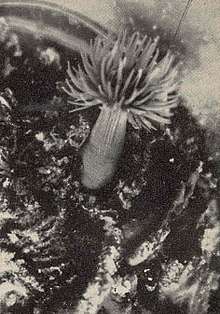Diadumene leucolena
Diadumene leucolena, commonly known as the white anemone or ghost anemone, is a species of sea anemone in the family Diadumenidae. It is an inconspicuous species found in the intertidal and subtidal areas of the northeastern Atlantic Ocean, the Caribbean Sea and the northern Pacific Ocean. Diadumene, "diadem-bearer", referring to the crown of tentacles, is a female form intended to bring to mind the Diadumenos, the renowned Greek sculpture of an athlete crowning himself with the victor's ribbon diadem.
| Diadumene leucolena | |
|---|---|
 | |
| Scientific classification | |
| Kingdom: | Animalia |
| Phylum: | Cnidaria |
| Class: | Anthozoa |
| Order: | Actiniaria |
| Family: | Diadumenidae |
| Genus: | Diadumene |
| Species: | D. leucolena |
| Binomial name | |
| Diadumene leucolena | |
| Synonyms[2] | |
| |
Description
When fully extended, Diadumene leucolena has a long and slender column, being up to 38 mm (1.5 in) tall and 12 mm (0.5 in) wide. Both column and tentacles are a translucent pale pink or flesh-colour, the column sometimes having a faint green tinge near the top. The column appears to be smooth but close inspection shows irregularly arranged darker swellings. The tentacles closest to either end of the mouth have yellow bases.[3][4]
Distribution
D. leucolena is found in the North Atlantic Ocean and the Caribbean Sea, and the North Pacific Ocean.[2] This is a shallow water species occurring in bays and areas of low salinity, on stones, on the shells of live oysters and on man-made structures such as pilings and floats.[3][5]
Biology
D. leucolena reproduces sexually, males and females liberating their gametes into the sea. The fertilised eggs develop into planula larvae which disperse, settle on the seabed, undergo metamorphosis and develop into new individuals.[6][7]
The closely related species, Diadumene lineata, (previously known as Haliplanella luciae) is a sympatric species of sea anemone living in the same habitats in the same localities. Unlike D. leucolena, it reproduces exclusively by asexual means, resulting in populations consisting almost entirely of cloned individuals. D. lineata has a tendency to thrive for a time, and then unexpectedly disappear from a locality. D. leucolena on the other hand, living in the same localities and conditions, has stable populations. It is hypothesized that sexual reproduction in the latter gives genetic variability and the flexibility to cope with adverse circumstances, while the asexually-breeding D. lineata, with hardly any genetic variability, succumbs when its limits of tolerance are exceeded.[6][7]
D. leucolena sometimes grows as a fouling organism, and has also been found attached as an epibiont on the carapace of a loggerhead sea turtle (Caretta caretta). Approximately two hundred individual sea anemones were present in grooves in the carapace that had been caused by the blades of a propeller; these depressions provided a relatively sheltered habitat for this species which is intolerant of turbulence.[8]
References
- Verrill, A.E. (1866). "On the polyps and echinoderms of New England, with descriptions of new species". Proceedings of the Boston Society of Natural History. 10: 333–357, 336.
- Fautin, Daphne (2015). "Diadumene leucolena (Verrill, 1866)". WoRMS. World Register of Marine Species. Retrieved 13 July 2017.
- Laboratory and Field Text Invertebrate Zoology. Intertidal Invertebrates of the Central California Coast. University of California Press. p. 44. GGKEY:UF98Q9X9FDQ.
- Gosner, Kenneth L. (2014). A Field Guide to the Atlantic Seashore: From the Bay of Fundy to Cape Hatteras. Houghton Mifflin Harcourt. p. 98. ISBN 978-0-544-53085-0.
- Lippson, Robert L.; Lippson, Alice Jane (2009). Life along the Inner Coast: A Naturalist's Guide to the Sounds, Inlets, Rivers, and Intracoastal Waterway from Norfolk to Key West. University of North Carolina Press. p. 210. ISBN 978-0-8078-9859-8.
- Bell, Graham (1982). The Masterpiece of Nature: The Evolution and Genetics of Sexuality. CUP Archive. pp. 179–180. ISBN 978-0-85664-753-6.
- Shick, J. Malcolm; Lamb, Allen N. (1977). "Asexual reproduction and genetic population structure in the colonizing sea anemone Haliplanella luciae". The Biological Bulletin. 153 (3): 604–617. doi:10.2307/1540609. JSTOR 1540609.
- Frick, Michael G.; Williams, Kristina L.; Veljacic, David; Pierrard, Lianne; Jackson, James A.; Knight, Stacie E. (2000). "Newly Documented Epibiont Species from Nesting Loggerhead Sea Turtles (Caretta caretta) in Georgia, USA". Marine Turtle Newsletter. 88: 3–5.